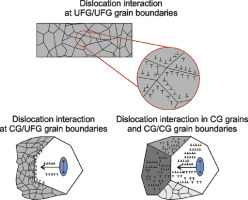当前位置:
X-MOL 学术
›
Acta Mater.
›
论文详情
Our official English website, www.x-mol.net, welcomes your feedback! (Note: you will need to create a separate account there.)
Deformation mechanisms and strain rate sensitivity of bimodal and ultrafine-grained copper
Acta Materialia ( IF 9.4 ) Pub Date : 2020-03-01 , DOI: 10.1016/j.actamat.2019.12.044 J. Bach , M. Stoiber , L. Schindler , H.W. Höppel , M. Göken
Acta Materialia ( IF 9.4 ) Pub Date : 2020-03-01 , DOI: 10.1016/j.actamat.2019.12.044 J. Bach , M. Stoiber , L. Schindler , H.W. Höppel , M. Göken

|
Abstract Materials with ultrafine grain size in the range from 100 nm to 1 µm exhibit very high strength paired with a satisfactory ductility when compared to their coarse grained (CG) counterparts. Although this typical behavior is already well known, the dominating deformation mechanisms are still controversially discussed in literature. One idea to explain the deformation behavior of ultrafine-grained metals is that deformation is mainly triggered by grain boundary sliding. Another explanation is that deformation in ultrafine-grained materials is controlled by the thermally activated dislocation annihilation of dislocations at grain boundaries. To gain deeper insights to the relevant deformation mechanisms in UFG metals a systematic study was conducted where the deformation behavior of UFG and bimodal copper (consisting of UFG and CG grains) is compared to the behavior of their CG counterparts. The UFG microstructure was obtained by equal channel angular pressing (ECAP). To achieve a bimodal or coarsened microstructure, specimens were annealed at 125 °C or, respectively, at 140 °C subsequent to the ECAP-process. Mechanical characterization and investigation on the strain-rate sensitivity were done by compression strain-rate jump tests at room-temperatures and elevated temperatures. It turned out clearly that the degree of bimodality determines the dominant deformation mechanism and the strain-rate sensitivity. In the UFG-state thermally activated annihilation of dislocations at the grain boundaries govern the mechanical behavior. For the bimodal microstructure the annihilation of dislocation at the interface of coarsened grains to the surrounding ultrafine-grained matrix dominate the mechanical behavior. For the fully coarsened state plastic deformation is mainly governed by dislocation interaction in the grain interior. In this regime, annihilation at grain boundaries plays only a minor role.
中文翻译:

双峰和超细晶铜的变形机制和应变率敏感性
摘要 与粗晶粒 (CG) 材料相比,超细晶粒尺寸在 100 nm 至 1 µm 范围内的材料具有非常高的强度和令人满意的延展性。虽然这种典型的行为已经众所周知,但主要的变形机制在文献中仍然存在争议。一种解释超细晶金属变形行为的想法是变形主要由晶界滑动触发。另一种解释是超细晶材料的变形是由晶界位错的热激活位错湮灭控制的。为了更深入地了解 UFG 金属的相关变形机制,进行了一项系统研究,将 UFG 和双峰铜(由 UFG 和 CG 晶粒组成)的变形行为与其 CG 对应物的行为进行了比较。UFG 微观结构是通过等通道角挤压 (ECAP) 获得的。为了获得双峰或粗化微观结构,试样在 ECAP 工艺后分别在 125 °C 或 140 °C 下退火。通过室温和高温下的压缩应变率跳跃测试,对应变率敏感性进行了机械表征和研究。结果清楚地表明,双峰的程度决定了主要的变形机制和应变率敏感性。在 UFG 状态下,晶界处位错的热激活湮灭控制着机械行为。对于双峰显微组织,粗化晶粒与周围超细晶粒基体界面处的位错湮灭支配了机械行为。对于完全粗化状态,塑性变形主要由晶粒内部的位错相互作用控制。在这种情况下,晶界处的湮灭只起次要作用。
更新日期:2020-03-01
中文翻译:

双峰和超细晶铜的变形机制和应变率敏感性
摘要 与粗晶粒 (CG) 材料相比,超细晶粒尺寸在 100 nm 至 1 µm 范围内的材料具有非常高的强度和令人满意的延展性。虽然这种典型的行为已经众所周知,但主要的变形机制在文献中仍然存在争议。一种解释超细晶金属变形行为的想法是变形主要由晶界滑动触发。另一种解释是超细晶材料的变形是由晶界位错的热激活位错湮灭控制的。为了更深入地了解 UFG 金属的相关变形机制,进行了一项系统研究,将 UFG 和双峰铜(由 UFG 和 CG 晶粒组成)的变形行为与其 CG 对应物的行为进行了比较。UFG 微观结构是通过等通道角挤压 (ECAP) 获得的。为了获得双峰或粗化微观结构,试样在 ECAP 工艺后分别在 125 °C 或 140 °C 下退火。通过室温和高温下的压缩应变率跳跃测试,对应变率敏感性进行了机械表征和研究。结果清楚地表明,双峰的程度决定了主要的变形机制和应变率敏感性。在 UFG 状态下,晶界处位错的热激活湮灭控制着机械行为。对于双峰显微组织,粗化晶粒与周围超细晶粒基体界面处的位错湮灭支配了机械行为。对于完全粗化状态,塑性变形主要由晶粒内部的位错相互作用控制。在这种情况下,晶界处的湮灭只起次要作用。



























 京公网安备 11010802027423号
京公网安备 11010802027423号